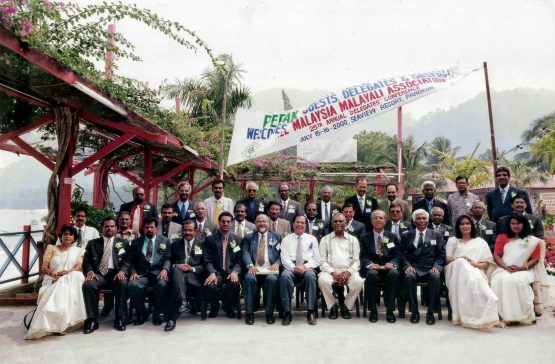
Our History

Kathakali, Traditional Indian Classical Dance from Kerala
After World War II there was an influx of Malayalees into Malaya. Most had come in search of employment and were successful. Though the bond with their home state was very strong, many decided to make Malaya their second home. This gave rise to an insatiable thirst for networking and creating a mini-Kerala to preserve their rich culture and tradition, and reactivate their beautiful language. As a result, the Malayalee community got together and set up self-help and cultural organisations.
That was how the Kerala Samajams or Malayalee Associations began. Literacy among the Malayalees was high, so cultural shows and organisations were a means through which they kept their culture and traditions alive. The community was seen converging during the Onam festival or celebrating a Malayalee wedding or welcoming a prominent literary figure from Kerala. With occasional meetings, interaction and camaraderie, the community indulged itself in community service. Leaders emerged from groups and followers. Soon by the end of the War, Kerala Samajams had sprouted in the various States. Not all were successful. The samajams in Penang, Selangor, Negeri Sembilan and Perak grew at a faster pace than the others.

Kalaripayattu, World’s Oldest Martial Art form, originated in Kerala

Selangor & Federal Territory Malayalee Association youths in Malaysia (1980s)
But, at whatever pace the Kerala Samajams grew, there was always a deep desire to keep in touch with other samajams, even peripherally. By the early l960s, a patchwork of communication was evident, linking the several Samajams so that each would know what the other was doing. This again was a natural development. The community was growing. Those children, born in Malaya and, later Malaysia, were growing up as Malaysian citizens, and firming the roots their parents had set up. Most of them decided to marry here, rather than seeking a bride from Kerala. All this meant that the community had to provide the wherewithal for that. Informal links were tightened.
It became obvious to many of them that the numerous Kerala Samajams ought to be linked through a central organisation. Before that, several Samajams had established informal links with each another. Closer links needed to be set up. Several of the Samajams and Malayalees were thinking along the same lines. Credit goes to Mr. A.C. Pereira for forming this Malaysia-wide organisation.
On 23 July 1972, a small working committee was set up with the help of Mr. P.C. Archibald at No.115-A Jalan Gasing, Petaling Jaya, to form the central organisation for Malayalees in Malaysia. Mr. Pereira was asked to organise an inaugural meeting of this body. That meeting was held on 30 August 1972 at the conference hall of the Malaysian Trades Union Congress in Petaling Jaya. Fourteen men and women attended that meeting. Mr. N. Raghavan, AMN, proposed that the organisation be called the All Malaysia Malayali Association or AMMA. The first Executive Council with all the fourteen members was set up.

Committee of the All Malaysia Malayalee Association (2000)

Mohiniyattam, Traditional Indian Classical Dance from Kerala
Though it was an auspicious beginning, AMMA found it hard going at first. The most difficult task was to get the idea accepted by Malayalees and their organisations elsewhere. There was much opposition to the nature of how the body was formed. But if someone had not taken the initiative, as Mr. Pereira had, the concept of AMMA would not have been realised. With the help of prominent Malayalees, who saw the need for such an organisation but were not in a position to take the lead for personal and official commitments, the idea of AMMA became a reality. Soon a draft constitution was drawn up. It was accepted with minor modifications by the Registrar of Societies and was officially registered on 13 July 1975 (Regn. No: 1647 – Sel.).
The cultural bias of the organisation was reiterated in the constitution. The contributions of Mr Kenny D’Cruz, Mr J.G.Bernatt, the late Mr N.S.Gopinath and the late Mr M.N.Menon were pivotal and commendable. The last two were Secretaries of AMMA. SFTMA (formerly known as Selangor Kerala Samajam), NSKS, PMA, MKS and LPMA were the first five affiliates of AMMA.
AMMA’s success is also seen in the way the youth wing and the ladies wing have got into the spirit of keeping Malayalee traditions alive. There is much enthusiasm among them that some of them have moved up to the main committee of AMMA and the Board of Directors of the AMMA Foundation. They have organised several conventions to bring together youths and ladies from all over the country – in Seremban, lpoh, Johore Bahru, Banting, Port Dickson, Kuala Lumpur and Penang.

Theyyam is a popular ritual form of worship in Kerala, India.

